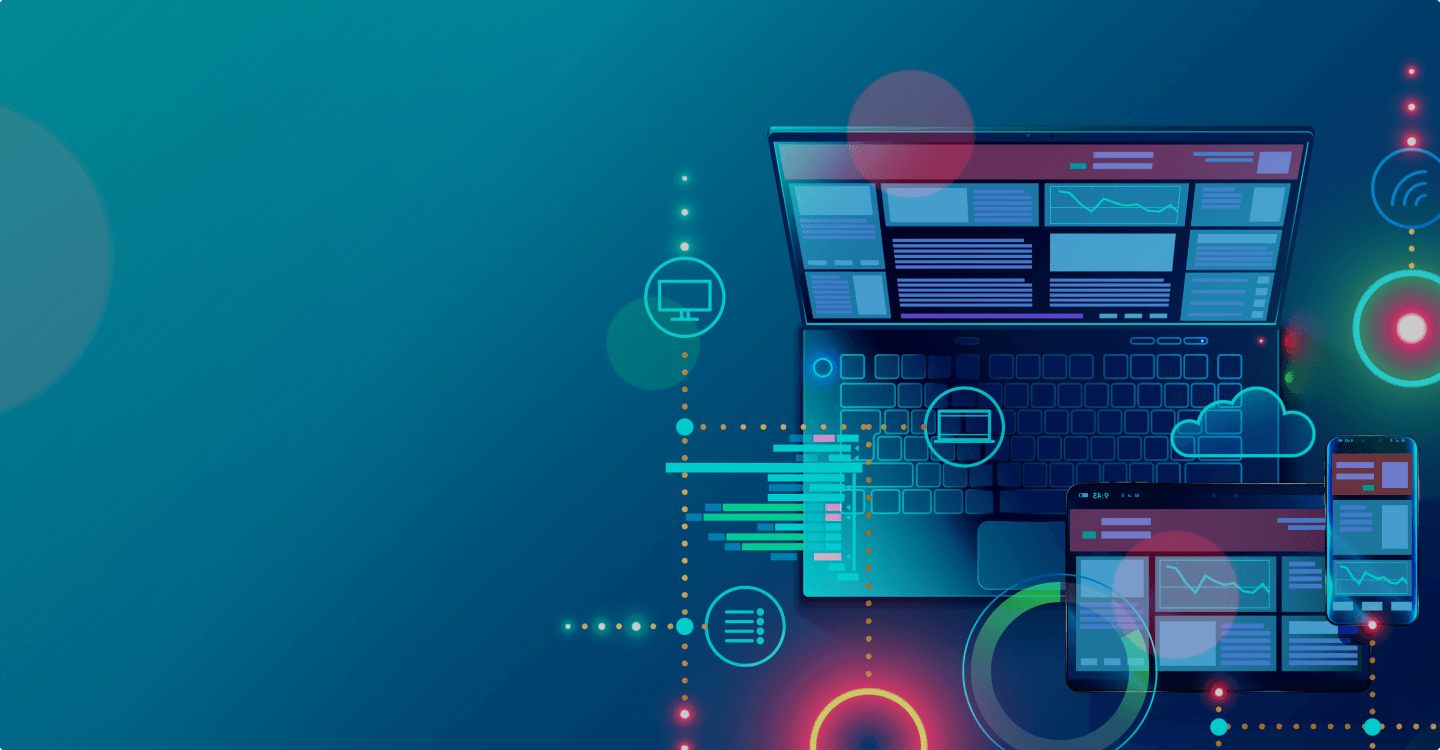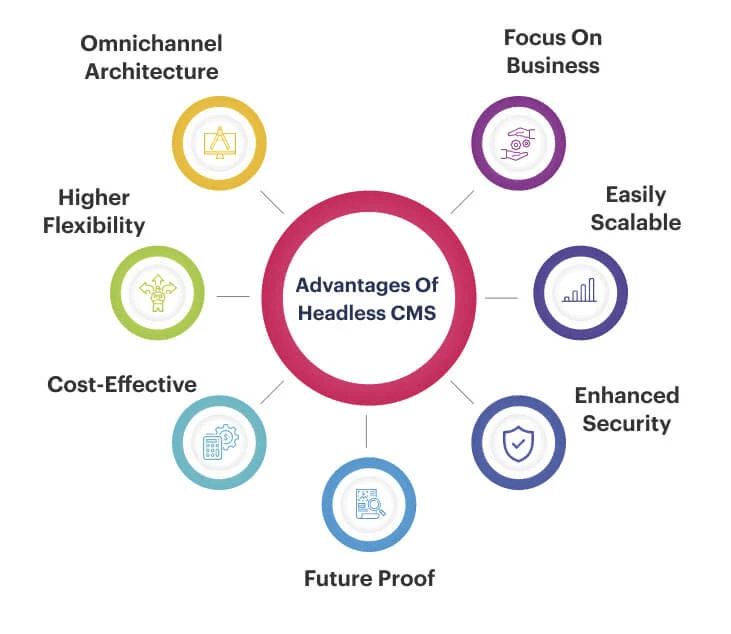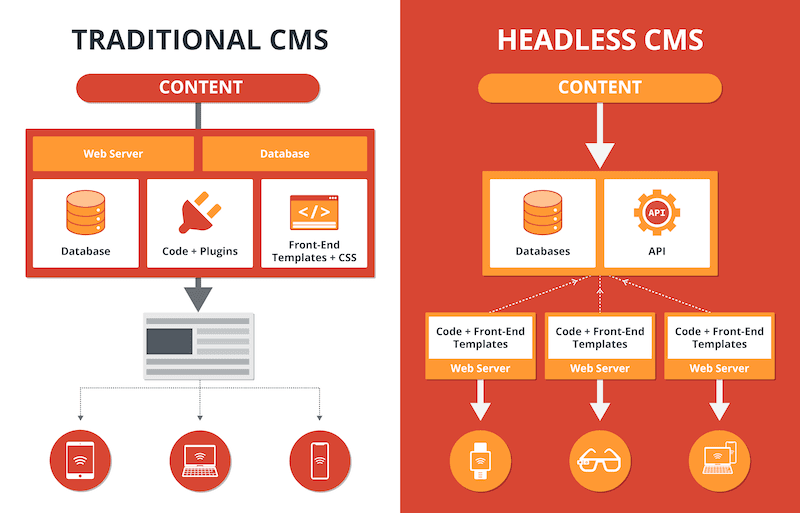
Headless CMS
Ildar BibaevFebruary 1st, 2023
Brief summary
What is Headless CMS?
It's pluses and minuses
Traditional vs headless CMS
Best headless CMS by Alt-team's point of view
Scroll to read all the article.
The world of computer technology is constantly developing. The same holds for content management systems.
While using traditional CMS has been the standard, a lot of companies are now looking for flexibility, security, and fast loading for their websites. All of these demands are met by headless CMS solutions.
What is a Headless CMS?
A headless content management system, also known as a Headless CMS, is a backend content management system designed primarily as a content repository. It offers exceptional functionality across various interfaces, irrespective of the platform or device type.

A Headless CMS enables content to be accessed through an API (Application Programming Interface) and microservices, allowing it to be displayed on any device without a built-in frontend. The term "headless" refers to the system operating without a frontend interface. This unique approach enables seamless integration of any frontend developed in any programming language with the core of the Headless CMS. Additionally, this system has the ability to work simultaneously with multiple distribution channels, which is one of the major advantages of a Headless CMS known as omnichannel capability.
What is a headless CMS good for?
Wondering why people are opting for headless CMS? Compared to traditional CMS, a headless CMS makes it much easier to push content to each platform, saving content authors a lot of time on reformatting content for various interfaces.
Additionally, there are several enticing benefits that make headless CMS an attractive choice. Here are a few significant reasons:
Personalized User Experience: A headless CMS enables businesses to deliver personalized user experiences by separating the backend content management from the frontend presentation. This flexibility allows for tailored and dynamic experiences, boosting customer engagement and satisfaction.
Multichannel Distribution: Headless CMS supports multichannel distribution, allowing content to be delivered across various platforms, devices, and channels. This ensures consistent messaging and brand presence across different touchpoints.
Increased Audience Reach: With a headless CMS, businesses can effectively reach a larger audience. Leveraging APIs and microservices, content can be easily distributed to different platforms and devices, expanding the brand's reach.
Scalability: Scaling your business becomes easier with a headless CMS. The separation of the frontend and backend enables independent scaling, ensuring the system can handle increased traffic, user interactions, and content requirements without sacrificing performance.
Alongside these reasons, there are numerous other advantages associated with headless CMS. Let's delve deeper into each of them for a comprehensive understanding.
Advantages of Headless CMS
There are a lot of advantages of Headless CMS along with omnichannel:
Convenient work with the system. Centralized management makes easier the interaction with different platforms. It is possible to add and change the content and make some settings using one administration panel.
Increased security. In fact the clients receive a static content, that’s why potential hacking attacks by direct database queries are almost excluded.
Quick implementation of new projects. Headless CMS makes it possible to launch a website or any application much faster due to flexibility of the content usage. Developers shouldn’t create special technologies or tooling for new projects start-up. The same Headless CMS core can be successfully used for website creation and for app creation.
Focus on micro services. Nowadays a lot of teams provide their tasks execution using micro services. It is considered to be mainstream as well as an opportunity of easy project scaling and work simplification.
High performance. Static content is more adaptive for different search systems enabling the websites to upload its content quicker. It also assists in attraction of visitors and potential customers. People like fast websites. Google also pays more attention to excellent website performance and ranks these sites higher than their competitors by key phrases.
Easy maintenance for developers. There is no need to engage a new specialist to make some special settings. But it depends on developer experience.

Disadvantages of Headless CMS
Besides a great number of pluses, a headless CMS has several disadvantages:
Headless CMS is regarded as an instrument for professional programmers only, who can integrate and make all necessary settings. Prepare to pay money for it. Check the prices of JamStack developer work.
Most large projects are supposed to be implemented by teams consisting of many professional developers. The working language is English. There is not many multilingual projects.
Difficult to see a live preview without significant development assistance
High costs are connected with the necessity to keep a headless CMS in the cloud service in order to provide quick availability and query execution.
Headless CMS vs Traditional CMS

Traditional content management systems are developed only for one website or interface, including individual architecture, content, and settings. This approach requires extensive resources and a large team of professionals, limiting digital opportunities.
A headless CMS is slightly different. It solves the problem of content management using different platforms. The content can be created, stored, and modified regardless of the way it is displayed on the client equipment (smartwatches, web browsers, or smartphones). This type of CMS is connected with static website generators and has a jamstack architecture.
Best Headless CMS
About 50 different Headless CMS systems are presented nowadays.
Several popular Headless CMS connected with Jamstack are provided in no particular order below:
Contentful

Contentful is the platform enabling to create, manage and update the content of the website, a mobile app or any other platform that displays content.
With an uncluttered user interface, Contentful is an efficient tool for creating and managing the content online, either alone or in team. Assign custom roles and permissions to team members, add validations depending on the kind of content you have to insert and add media such as images, documents, sounds or video. It also integrates with hundreds of leading-edge tools for translation, segmentation, ecommerce and more.
Contentful has several editions:
Community (free version);
Team (from 489 usd/month);
Enterprise (payment depends on the customer's demands).
Storyblok
Storyblok is the only Headless Content Management System with a Visual Editor. It provides developers with all the flexibility they need to build reliable and fast websites, while giving content creators with no coding skills the ability to edit content independently of the developer.
Developers can now focus on providing more value for the customers instead of maintaining the monolithic backend infrastructure. By integrating with the Storyblok, the content is decoupled from the presentation layer, which means that it is possible to choose any frontend technology.
Storyblok is the world's first headless CMS that works for both developers and business users who apply it to deliver powerful content experiences on any platform: Corporate websites, ecommerce sites, mobile apps, and screen displays.
Storyblok has several editions:
- Community (free version);
- Entry (from 90 usd/month);
- Teams (from 449 usd/month);
- Enterprise (from 2999 usd/month).
Ghost - open-source Headless CMS.
It is a professional platform with open source code based on Node.js technologies and developed for large projects and most of all for blogs.
Ghost is an entirely free Headless CMS that can be easily installed on any server and arranged for work with different types of database (MySQL, SQLite3, and others) and any internal and external storages.
It is also possible to use other editions for additional payment:
- Ghost Pro (from 29 usd/month);
- Standard (from 79 usd/month);
- Business (from 199 usd/month).
Strapi - open-source Headless CMS.

It is one of the most popular open-source CMS based on JavaScript, which can be easily integrated with any type of interfaces including static interfaces and those that are created using different frameworks and tools. Administration panel has a modern and convenient interface suitable for any requirements of the customer.
Strapi is an entirely free Headless CMS that can be downloaded and installed on any server equipment. Subscription packages are necessary only for technical support by the team of professional developers. It is also possible to use other editions for additional payment:
- Bronze (from 29 usd/month);
- Silver (from 299 usd/month);
- Gold (payment depends on the customer's demands).
This Headless CMS is good for creation of different projects such as information websites.
Sanity - open-source Headless CMS.

It is one of the best cloud platforms of the corporate level based on React. Sanity can be easily integrated with any type of interfaces and is widely used in the large companies such as Figma, Nike, Netlify, etc.
Developers provide a special application with open-source code Sanity Studio for more convenient work with the content, which can be modified in real time by involved programmer in order to avoid any mistakes.
Sanity CMS has several editions:
- Standard (free version);
- Advanced (from 199 usd/month);
- Enterprise (payment depends on the customer's demands).
It is also possible to buy additional services for any tariff.
This Headless CMS is suitable for creation commercial projects (e-commerce).
Cockpit - open-source Headless CMS.

It is one of several open-source Headless CMS that can be installed on traditional shared-hosting supported by MySQL / SQLite databases and PHP software language. Cockpit can be easily integrated with any type of interfaces and is compliant with local or network repository.
This Headless CMS is free to download and use, but it is possible to ask for chargeable technical support.
Netlify

It is one more single remote Headless CMS for the static sites generators. This system provides the simple modification and content addition to any HTML site. It speeds up and simplifies the maintenance process of small sites and mobile applications created with Gatsby, Hugo, Jekyll, etc.
Netlify is an entirely free Headless CMS that can be used by non-professionals and small teams of developers.
Netlify CMS has several editions:
- Starter (from 0 usd/month);
- PRO (from 19 usd/month);
- Business (from 99 usd/month);
- Personal (payment depends on the customer's demands).
Headless CMS are simple and quick solutions that can easily substitute the whole back end for different web applications. The functionality is limited, but it is quite enough to implement the content management system to the project quickly by any professional programmer. That's why it is possible that Headless CMS will be more preferable in future than traditional WordPress or Joomla.
Leave your comment
Your feedback is very important to us. Share your thoughts on what you read, or tell your own story.
Rating